New COVID-Related Data Assesses Risk, Stimulus Spending
Cases continue to rise, just as families typically start planning for the holiday season. How can you assess your risk? We have some new tools to share and more in today’s bullet points.
- New COVID-related data on stimulus spending, assessing risk;
- County sees massive uptick in COVID-19 cases over weekend;
- City, Dallas ISD mapping internet speed – and you can help;
- Abbott announces distribution of COVID-19 antibody therapy to Texas hospitals.
New COVID-Related Data on Stimulus Spending, Assessing Risk
We see the numbers increase – and over the weekend, Dallas County Judge Clay Jenkins even warned that without some massive switch in behaviors, the county could be looking at 2,000 cases a day by Thanksgiving.
But what does that mean?
We’ve got two different options that give a better idea of what those numbers mean – especially on the state level.
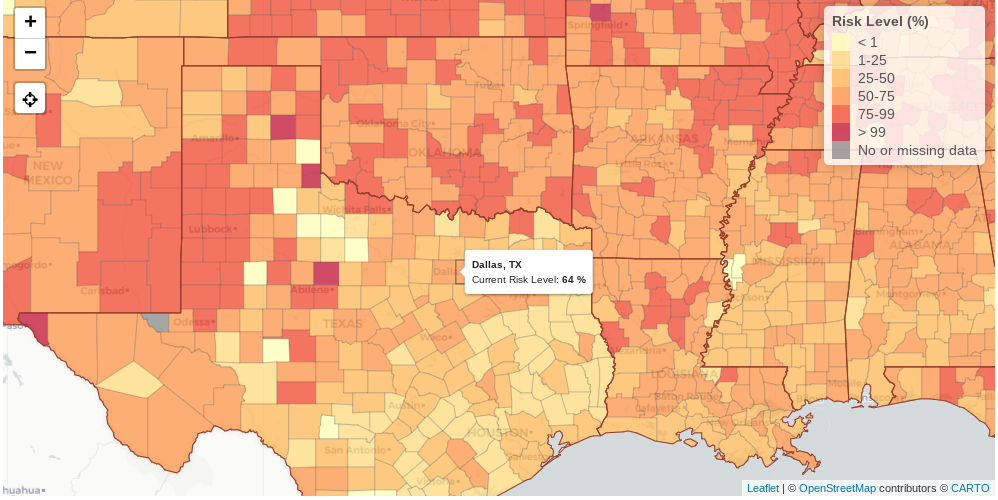
For one, we have a peer-reviewed risk-assessment tool from Georgia Tech. The tool is crafted to help anyone – from schools to cities to event planners to even individuals figure out what kind of risk they’re looking at if they decide to gather with people they don’t live with.
For instance, having 15 people over in Dallas County gives you about a 26% risk of contracting COVID-19. Bump that up to 25 and you’re at 40%. Want to invite 50? Your risk goes up to more than 60%.
The COVID-19 Tracking Project at The Atlantic’s weekly review shows that in Texas, one in 493 tested positive for COVID-19 in the seven days prior to Nov. 12.
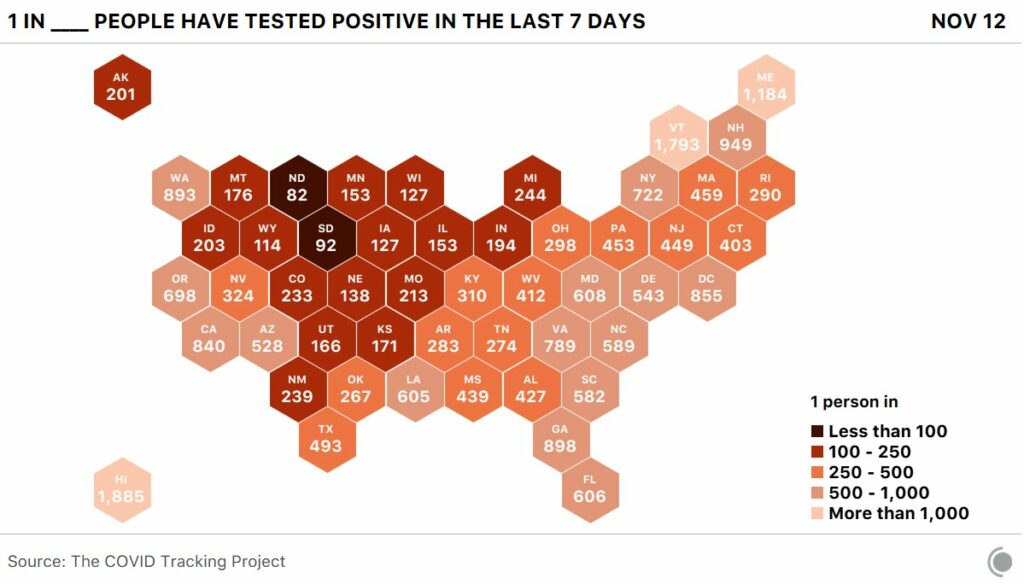
Another data point looks more at the economic aspects of the pandemic – namely, what people used their stimulus checks on.
The Economist reports that three economists – Olivier Coibion, Yuriy Gorodnichenko and Michael Weber – used data from a Nielsen survey to discover that just 42% of the stimulus money was actually spent. Twenty-seven percent of it was saved, and 31% used it to pay down debt.
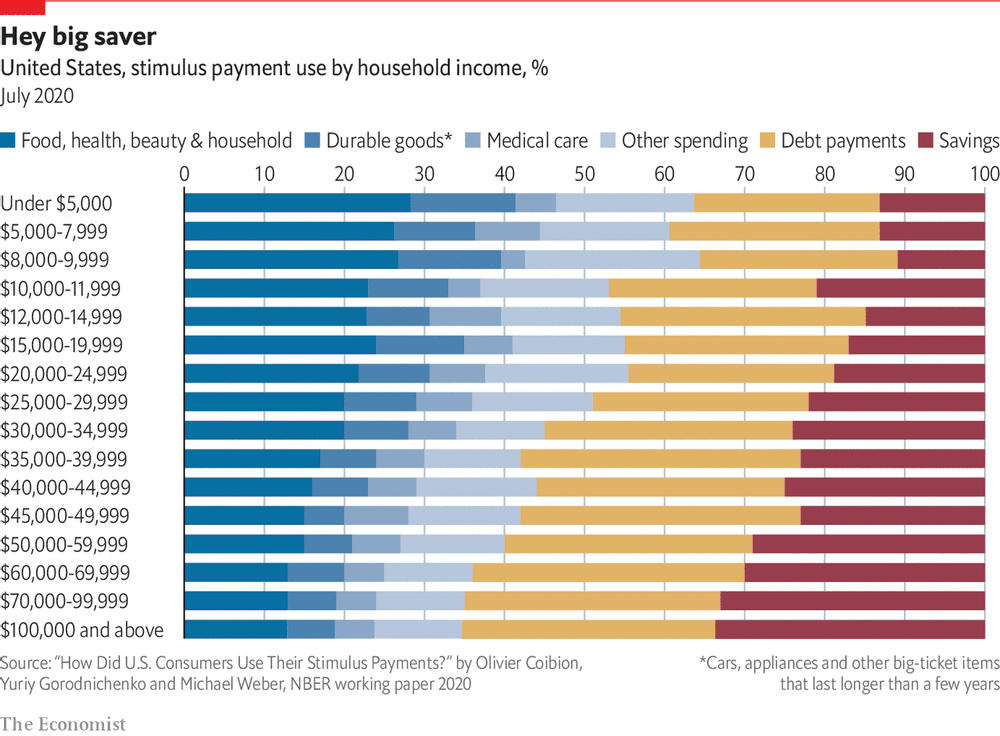
“These results may seem disappointing, given that the primary aim of the stimulus was to boost consumption,” the report said. “But they conceal wide variation across households. The authors found that 30% of Americans spent their entire stimulus check, while 40% did not spend any at all. As you might expect, poorer households spent more of their payments, with the bulk going on food and other essentials; bigger households spent more, too.”
You can see the whole report here.
County Sees Massive Uptick in COVID-19 Cases Over Weekend
A total of 3,234 new confirmed cases of the novel coronavirus were reported by Dallas County health officials between Friday and Sunday, and an additional 534 probable cases were reported, along with three deaths.
On Friday, the county reported 767 cases (499 confirmed cases and 268 probable) and one death; on Saturday, 1,543 cases (1,454 confirmed and 89 probable) and one death; and on Sunday, 1,458 cases (1,281 confirmed and 177 probable) and one death.
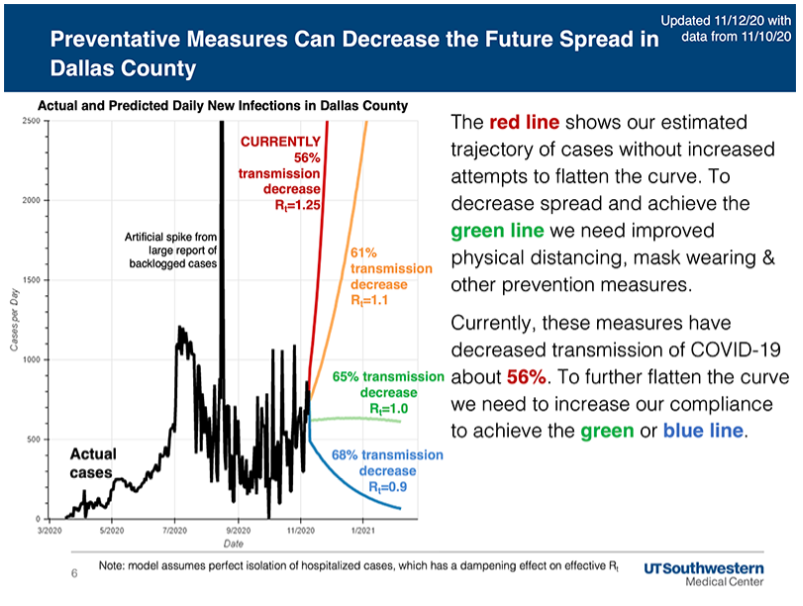
Cumulatively, there have been 109,022 sickened so far with COVID-19, and 1,142 have died from it.
Among the dead are a woman in her 40s with underlying high-risk health conditions, a man in his 50s, and a man in his 90s who had underlying high-risk health conditions. All were from Dallas.
The county said that the number of COVID-19 hospitalizations Friday was 605 patients, up from 501 last Friday. Emergency room visits for COVID-19 symptoms represented about 20% of all ER visits, according to information reported to the North Central Texas Trauma Regional Advisory Council.
“Today ends an explosive growth week in COVID infections with 1,543 new cases to report today and one death,” Jenkins said Saturday. “For the week, we’ve reported the loss of 13 of our residents and we are averaging 1,131 cases per day for the week ending today.”
Jenkins said that the county’s use of the CDC weeks for accuracy does have one downside – it has a lag of about seven days.
“That report shows that for CDC week 45 ending on November 7, 2020, we increased to 958 cases per day, which is a rate of 37.4 daily new cases per 100,000 residents,” he explained. “The percentage of respiratory specimens testing positive for SARS-CoV-2 (COVID) remains high, with 15.3% of symptomatic patients presenting to area hospitals testing positive in week 45.”
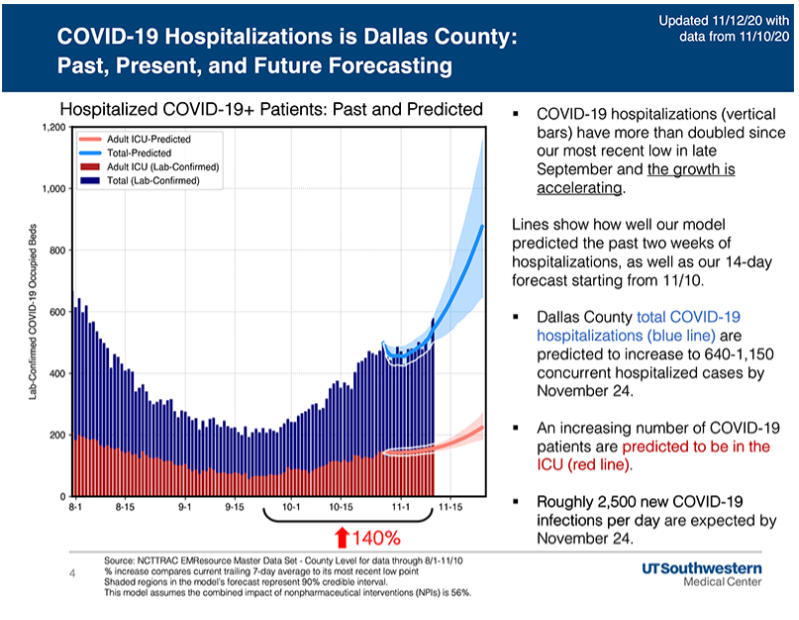
UT Southwestern’s latest forecast projects that by Nov. 24, Dallas County hospitals could see concurrent hospitalizations rise to between 640 and 1,150 cases, with roughly 2,500 new cases per day on average.
“In Dallas and Tarrant counties, hospitalizations are expected to exceed previous highwater marks in the next week or so,” researchers said.
According to trackers provided by Dallas ISD and Highland Park ISD, cases of COVID-19 are cropping up at schools. On Friday, Dallas ISD’s COVID-19 dashboard indicated that there were now 975 cases (an increase from 757 a week ago) throughout the district – 386 among campus staff (up from 292), 99 among central staff (up from 73), and 490 among students (up from 392).
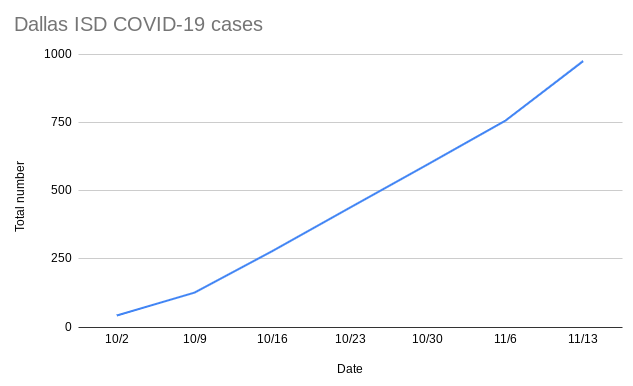
Hillcrest High School has 13 cases, W.T. White High School has 16 cases (up from 13), Thomas Jefferson High School has 19, Marsh Middle School has three cases (up from 1), Benjamin Franklin Middle School has four, Medrano Middle School has seven (up from two), Longfellow has one, Walker Middle School has one, Dealey Montessori has three, Walnut Hill Elementary has 16, Sudie Williams has two, Nathan Adams Elementary has one, Pershing Elementary has two, Withers Elementary has four (up from three), Gooch Elementary has eight (up from six), Kramer Elementary has three, Preston Hollow Elementary has one, and K.B. Polk has two cases (up from one).
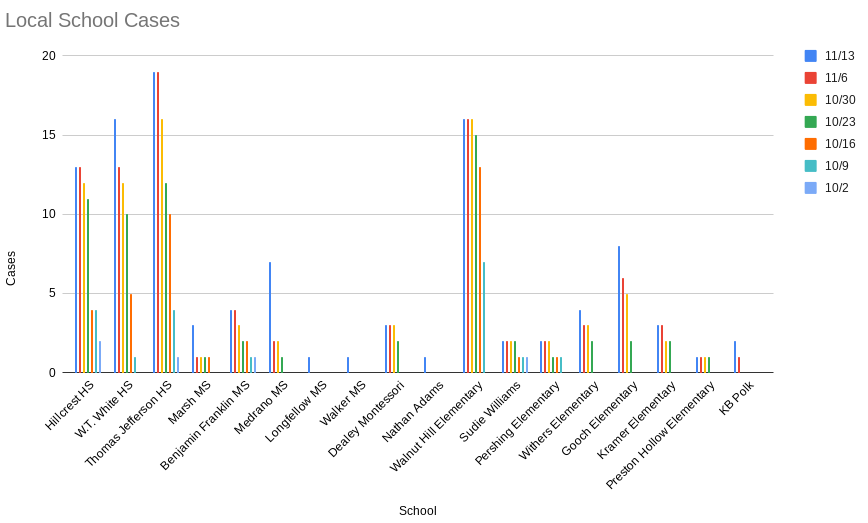
Highland Park ISD is reporting six staff cases and 12 student cases. Neither district provides information on how many students and staff have quarantined due to classroom exposure to the virus.
Dallas County reported Saturday that a provisional total of 843 confirmed and probable COVID-19 cases were diagnosed in school-aged children (5 to 17 years) during CDC week 45 – the week ending Nov. 7, a 37% increase from the previous week. Last week, 10 schools in Dallas County were temporarily closed to in-person instruction because of outbreaks of COVID-19.
In the county’s Nov. 13 aggregate report, the county broke down probable cases for children ages 5 to 17 by city. Dallas children in this age group with confirmed or probable cases of COVID-19 numbered at 357 for the week ending Nov. 7 and 287 for the week ending Oct. 31. Highland Park children numbered two for the week ending Nov. 7 and zero for the week ending Oct. 31. University Park children numbered five for the week ending Nov. 7 and four for the week ending Oct. 31.
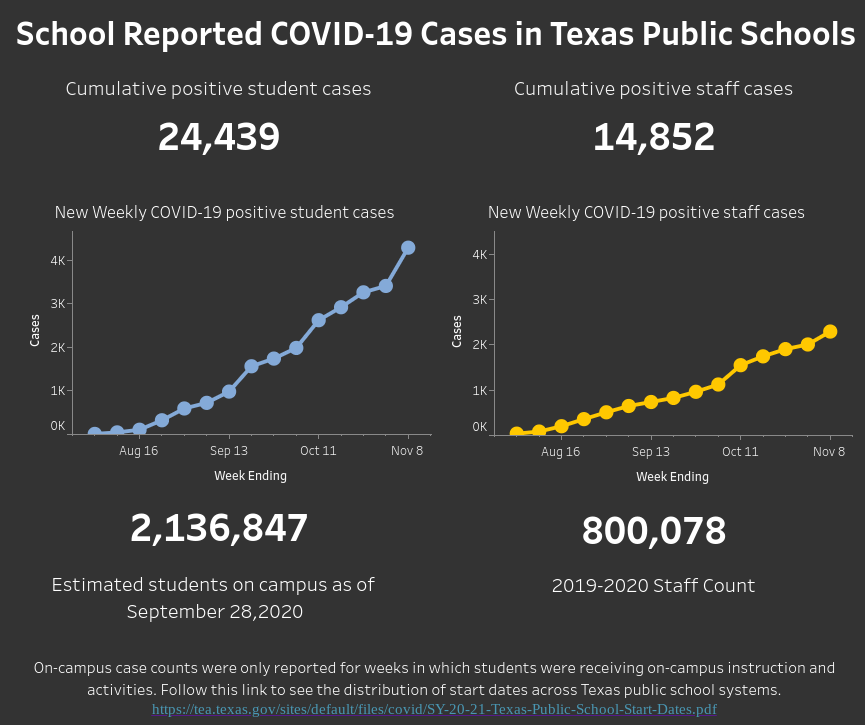
For the week ending Nov. 8, the state Texas Education Agency reported that 24,439 students tested positive for COVID-19, and 14,852 staff members, compared to the week before with 19,698 students and 12,289 staff members.
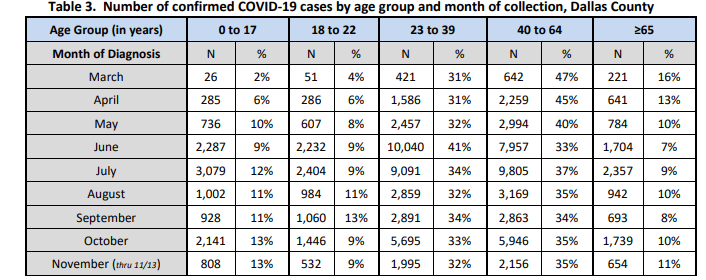
Dallas County reported in its Nov. 6 aggregate report that most confirmed cases continue to be between the ages of 18 and 60, with the 18-40 age group accounting for 46% of the cases, and the 41-64 age group accounting for another 34% of the total cases.
Of the testing done, positive cases accounted for 15.3% as of Nov. 7, with 1,432 positives coming from 9,361 tests. Testing for the week prior found that positive cases accounted for 15% of all testing.
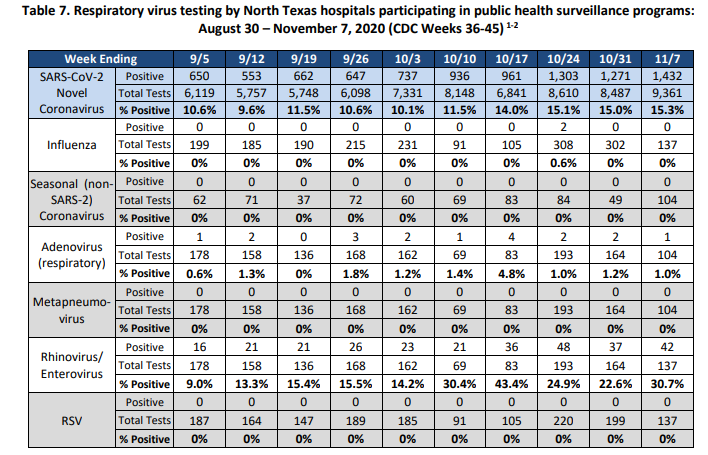
Nine percent of all cases ended up hospitalized – 23% ended up in intensive care, and 12% ended up on a ventilator. However, experts warn that deaths and hospitalizations are a lagging indicator, meaning that hospitals may not see the brunt of the current uptick for the next week or two.
In a city-by-city breakdown, Dallas still comes in with the highest number of cases – 54,202 confirmed cases and 4,984 probable cases. Highland Park has 142 confirmed cases (up from 123 last week) and a single probable case, and University Park has 387 confirmed cases (up from 360), and 397 probable cases.
“Not including the week we reported a very large backlog in cases from the state’s reporting system, the numbers that we have seen this week are the highest weekly average that we have seen thus far for new COVID cases and today’s total is the highest single day total that we have seen thus far,” Jenkins said. “What happens in the coming days as we approach Thanksgiving and the days after is dependent on each of you making good choices: telecommute to the fullest extent possible, stop visiting one another’s homes and avoid crowds during this time of extreme spread.”
City, Dallas ISD Mapping Internet Speeds, and You Can Help

Thanks to the pandemic, problems with internet infrastructure have been made glaringly obvious. The City of Dallas and Dallas ISD are working together to determine how to improve internet service.
One of those ways is super simple – a survey and speed test designed to gather data about the availability and speed of internet service. The two entities are asking residents to help them identify locations that lack internet service, as well as how fast their internet is if they do have service.
Abbott Announces Distribution of COVID-19 Antibody Therapy to Texas Hospitals
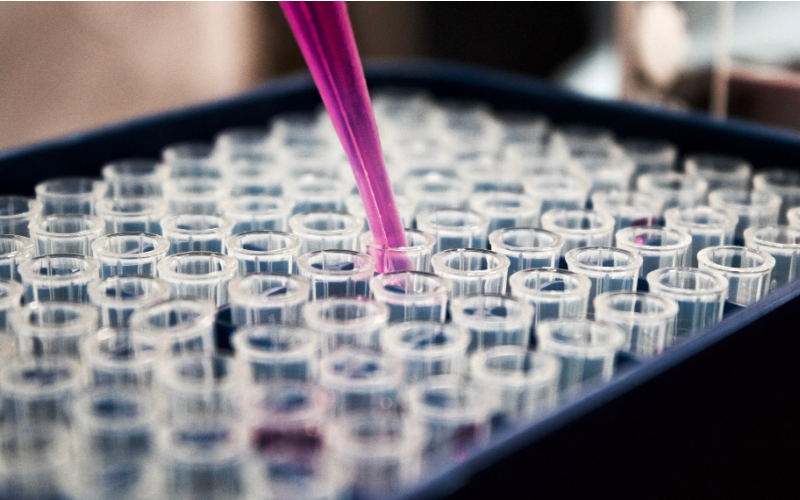
Gov. Greg Abbott announced that the Texas Department of State Health Services is allocating an initial shipment of bamlanivimab, the Eli Lilly & Company monoclonal antibody therapy, to be distributed as early as this week to acute care hospitals across every geographic region of the state.
These weekly shipments of doses have been provided to the state at no cost through the U.S. Department of Health and Human Services.
DSHS will allocate this initial distribution of bamlanivimab based on three criteria: new confirmed cases of COVID-19 in the community, new lab-confirmed COVID-19 admissions to hospitals, and total lab-confirmed COVID-19 patients in hospitals.
“This initial allotment of bamlanivimab will help health care professionals effectively treat cases of COVID-19 within their communities and aid in reducing hospitalizations,” said Abbott. “I thank the U.S. Department of Health and Human Services for providing Texas with this crucial antibody therapy that will help keep Texans safe and mitigate the spread of COVID-19.”
Bamlanivimab is for outpatient use in people who have tested positive for COVID-19 and are at increased risk of severe disease. It has been shown to prevent hospitalizations in some patients when used before they become very sick.









